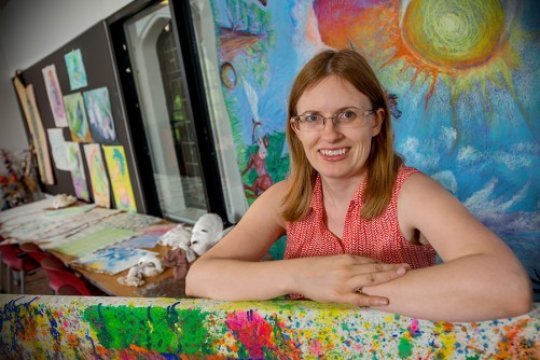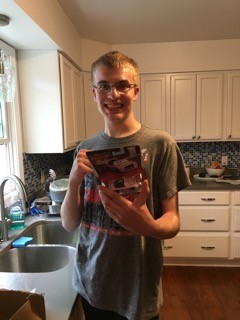Kid on the Autism Spectrum Becomes Eagle Scout
https://peoplescare.com/wp-content/uploads/2017/07/Screen-Shot-2017-07-28-at-1.46.18-PM-1024x788.png 1024 788 People's Care People's Care https://peoplescare.com/wp-content/uploads/2017/07/Screen-Shot-2017-07-28-at-1.46.18-PM-1024x788.pngIt’s an honor only six percent of the one million Boy Scouts in this country will ever receive: becoming an Eagle Scout.
One South Carolina teen has earned it despite some challenges along the way. Robby Rose has is on the autism spectrum, he says it’s the challenges we face that make our victories that much more meaningful.
“I don’t think they ever really gave me a chance, I was in special ed since I started school before I moved here. But now since I am regular ed, I feel like I have beaten my disability,” Rose said.
His mother said the teen has excelled beyond her dreams for him.
“He has grown more than I could ever have imagined. More than I ever hoped for,” said Robby’s mother, Cindy Griffith. “The best I ever hoped for was that he would mainstream in school and hopefully do enough to get a diploma. Now he’s excelling at even that.”
His band director, Debbie Cooper said music is what speaks to Robby and has opened the door to reveal his many talents. With band, Rose said he doesn’t know what he would do.
“Sometimes music reaches areas that have been never been touched before and open new doors,” Cooper said. “Now he is mainstreamed in the regular classes and then even in honors classes.”
No longer in special education courses, his GPA sits at 3.6 at Boiling Springs High School on the way to a diploma.
“Because of his speech, people mistake him as not being intelligent which is the furthest from the truth,” his mother said. “Just because he can’t say it doesn’t mean it’s not there and he can’t do it or feel it.”
Robby is proving autism won’t hold him back. If anything it’s pushed him to be the best version of himself, one deserving of an honor only six percent of Boy Scouts across this nation will ever see.
“It’s like getting a degree, you can easily get a job I sent you an eagle scout,” Rose said.
Rose became an Eagle Scout in April and will receive an official badge Sep. 3 during a ceremony.
His father has helped with Cubs Scouts and band practice, applauding Robby for his accomplishments.
“He put a lot of work in, going to all the camps doing on the merit badges,” Chris Griffith said. “They have to be able to survive in cold weather, they have to to tie knots, first aid how to cook things like that, maintenance on vehicles home maintenance.”
Rose has juggled school, band, boy scouts, against the odds he says were once stacked against him.
“No matter your disability, we all have victories, every day, every hour,” Rose said.”
[Source: http://www.foxcarolina.com/story/35992202/upstate-teen-with-autism-earns-eagle-scout-badge ]







 When T.J. was diagnosed with autism at age 2, we went through all the emotions, and tried every therapy we could find. We privately mourned the loss of the life we thought we would have, while happily and confidently accepting our new reality. We embraced his diagnosis with optimism, and even through tough times, our strong love for our children was always the driving force.
When T.J. was diagnosed with autism at age 2, we went through all the emotions, and tried every therapy we could find. We privately mourned the loss of the life we thought we would have, while happily and confidently accepting our new reality. We embraced his diagnosis with optimism, and even through tough times, our strong love for our children was always the driving force. But now, at age 17, T.J. is pretty much who he is going to be as an adult. Yes, many things are still up in the air and could change as he experiences the world, but he has largely been shaped. He is wonderful and smart and funny and caring and affectionate. He loves animals, Harry Potter, Pokémon, Power Rangers, Star Wars and Pixar. He is curious about the things that interest him. He gets stressed out easily in a variety of situations and, with some assistance, can calm himself down. He has a bad-boy streak, which manifests as a love of things deemed “inappropriate” in school (swear words, South Park, Family Guy).
But now, at age 17, T.J. is pretty much who he is going to be as an adult. Yes, many things are still up in the air and could change as he experiences the world, but he has largely been shaped. He is wonderful and smart and funny and caring and affectionate. He loves animals, Harry Potter, Pokémon, Power Rangers, Star Wars and Pixar. He is curious about the things that interest him. He gets stressed out easily in a variety of situations and, with some assistance, can calm himself down. He has a bad-boy streak, which manifests as a love of things deemed “inappropriate” in school (swear words, South Park, Family Guy). We never let T.J. see that we were struggling with that realization. We didn’t want him to feel responsible for our preconceived notions of what his life should look like.
We never let T.J. see that we were struggling with that realization. We didn’t want him to feel responsible for our preconceived notions of what his life should look like.

